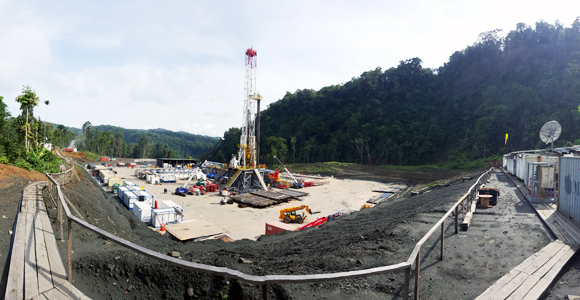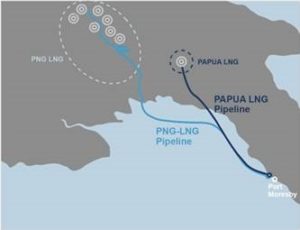Oil Search, Papua New Guinea’s biggest company and largest non-government employer, looks set to consolidate its position as a major player in the Asia-Pacific oil and gas market with its proposed US$2.2 billion (K6.96 billion) purchase of InterOil. Chief Executive of Oil Search, Peter Botten, says it will allow the company to be ‘hugely influential in the further development of our world class PNG LNG and Papua LNG assets.’

A test well at Antelope gas field. Credit: InterOil.
Oil Search has announced two deals. First is the proposed full acquisition of InterOil. Second is the signing of a Memorandum of Understanding with the French major Total SA to sell down 60 per cent of InterOil’s interest in the Elk-Antelope gas reserves and 62 per cent of InterOil’s interest in other exploration assets. In return, Total will take up 60 per cent of the acquisition cost (US$1.2 billion, or K3.8 billion).
Alignment

A map showing the proximity of PNG’s two LNG projects. Credit: InterOil
Botten says this will establish a ‘long term alignment with Total’ and reduce the risks to Oil Search. According to Stephen Gardiner, Chief Financial Officer of Oil Search, the company’s net debt will decrease by US$300 million after the deal.
There are also expected to be savings on capital expenditure and operational expenditure and an acceleration of production schedules.
Full price
David Lennox, Resources Analyst for Fat Prophets, says Oil Search has paid a full price, but has created strategic options.
‘It puts those fields into fewer hands and Oil Search spreads it costs to develop those fields back to Total as well.
‘Total is taking up the bulk of the costs of Elk and Antelope.’
‘Total is taking up the bulk of the costs of Elk and Antelope and also the exploration fields. Oil Search won’t have to fund the development of those fields.

Fat Prophets’ David Lennox
‘With fewer hands in the till, less people have to be involved in determining whether or not Papua LNG will become a commercial entity in due course, or whether or not they do some deal with PNG LNG and perhaps put an extra train there.
‘It gives Oil Search optionality. That is the key takeaway.’
Windfall
Lennox says the PNG Government is likely to be positive on the deal.
‘If they can get Papua LNG up and running as successfully as PNG LNG is now running then you would suggest that is going to be a windfall for the PNG economy, ‘ he told Business Advantage PNG.
‘In the short term, though, it is in fact detrimental because the company is likely to consolidate operations. We may see a little bit of a dip in the impact the two companies would have had stand-alone. But only in the very near term.’
Lennox adds that the Papua LNG project is likely to be built in a lower capital intensive environment. ‘The cost of building the thing will be less than PNG LNG, but one would think that operationally they will be very similar.’
Abundant supply
Much of the success of the Papua LNG project will depend on what happens to oil and gas prices. Andrew Barry, Lead Country Manager for Exxon Mobil in PNG said at the Australia—Papua New Guinea Business Forum in Cairns that new technologies are transforming the global energy landscape, particularly in North America. It is, he said, ‘reshaping global markets.’

ExxonMobil’s Andrew Barry
‘Today, the world has an abundant supply of natural gas: more than two centuries’ worth at current demand levels,’ he said. ‘This is thanks to advances in both unconventional and conventional technologies.’
Barry said the long term outlook for LNG demand is for it to rise by 5-6% per year on average through to 2025. Demand for LNG is expected to increase by twice the rate of demand for gas.
‘According to many analysts, the LNG projects that are currently under construction globally will have already added three quarters of that supply needed to meet the demand by 2025,’ he said.
‘Only the most economic projects will proceed in what will be a tough environment.’
‘There is a very strong case to get together and co-operate.’
Lennox agrees that there is a ‘prevalence’ of natural gas fields around the world, and notes the ability to transport gas around the world is also improving. He believes there will be a ‘move away from coal towards natural gas over the next 10-to-15 years.’
Increased holding

Oil Search’s Peter Botten
Oil Search is set to increase its holding in the Papua LNG project to 29 per cent and Total will increase its holding to 48 per cent, assuming the PNG State exercises its option to buy into the project. The company is claiming the deal will enable a doubling of LNG production by 2022-23.
Botten says the deal will provide a pathway for integration between the two big oil and gas projects: PNG LNG and Papua LNG:
‘There is a very strong case to get together and co-operate.’ he says, adding that the PNG government is ‘fully behind’ both the transaction and ‘greater co-operation between the big players,’ he told an investors’ briefing last Friday.








Speak Your Mind